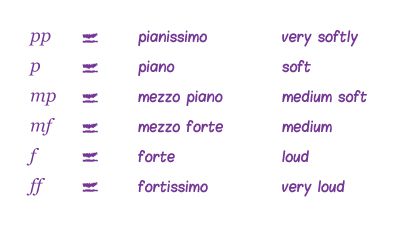Dynamics is the term used to indicate the loudness or softness of musical sounds. The loudness and softness of sound is called the volume. A series of symbols tell the performer when to play loudly or more softly and when to change from one to the other. From pianissimo (very softly) to fortissimo (very loud), music ranges from a whisper to the fullest of sound.
Dynamics Details
This is a list of symbols of the most commonly used dynamics:

Sudden Changes in Volume
In addition to the basic symbols listed to the left, another dynamic indication includes sforzando, a strong, accent, abbreviated as sf or sfz; and fp (or sfp), which indicates sforzando followed immediately by piano.
Gradual Changes in Volume
Sometimes a composer may want the music to get gradually louder or gradually softer. The two most common terms are crescendo, sometimes abbreviated to cresc., meaning “get gradually louder”; and decrescendo or diminuendo, sometimes abbreviated to decresc. or dim., meaning “get gradually softer”. Signs, sometimes called “hairpins,” are also used to stand for these words.
These are made up of two lines that connect at one end and get gradually further apart. If the lines are joined at the left, then the indication is to get louder; if they join at the right, the indication is to get softer.

Test Your Knowledge
How well do you know your dynamics? Check using the flip cards below!
